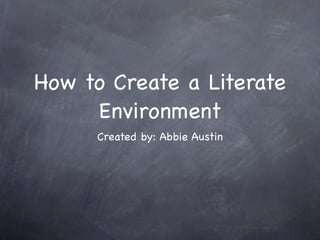
Literate environment presentation
- 1. How to Create a Literate Environment Created by: Abbie Austin
- 2. Getting to Know Literacy Learners Before you can create a literate environment you must know your students: Who is the child as a reader? What are their interests and experiences? What is their motivation and attitude towards reading?
- 3. Getting to Know Literacy Learners To know your students you must collect data from both cognitive and noncognitive assessments. Noncognitive Assessments Cognitive Assessments (motivation, attitude, perception as a (reading skills) reader) Elementary Reading Attitude Survey DIBELS (Good, R. H., & Kaminski, R. (McKenna & Kear, 1990). A., 2007) Assessing Motivation to Read Developmental Reading Assessment (Gambrell, L. B., Palmer, B. M., Codling, (DRA) (Beaver, 2006). R. M., & Mazzoni, S. A., 1996)
- 4. Selecting Texts Selecting appropriate texts for students is essential. Students need a balance of different types of books. One way to help in selecting books is to use the Literacy Matrix (Laureate Education Inc., 2010). Linguistic - word oriented Easy Other important factors to consider when selecting texts: Narrative Informational Readability Hard Text Length Semiotic - picture oriented Text Structure Size of Print Visual Supports
- 5. Interactive Perspective The interactive perspective involves teaching students how to read. Students learn to become strategic and metacognitive readers and writers. Students learn to use comprehension strategies such as: making connections, using background knowledge, mental images The key to this perspective is the instructional techniques that are used. You must first explain, model, and use reading strategies.
- 6. Critical Perspective The Critical Perspective teaches students to critically examine text. When students think critically about a text they are thinking about the purpose or the text, perspective of the author, and different points of view (Laureate Education Inc., 2010). Some activities to think critically about a text are: book talks, grand conversations, open-mind portraits, and interactive read-alouds (Tompkins, 2010).
- 7. Response Perspective The Response perspective teaches students to respond to text. Students need to be exposed to literacy experiences that will affect them personally and emotionally (Laureate Education Inc., 2010). Some ways to respond to a text are: response journals or reading logs, grand conversations, and book talks (Tompkins, 2010).
Editor's Notes
- \n
- \n
- \n
- \n
- \n
- \n
- \n